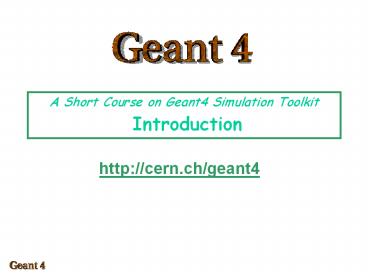A Short Course on Geant4 Simulation Toolkit Introduction - PowerPoint PPT Presentation
Title:
A Short Course on Geant4 Simulation Toolkit Introduction
Description:
design of the experimental set-up ... DPM. EA-MC. FLUKA. GEM. HERMES. LAHET. MCBEND MCU. MF3D. NMTC. MONK MORSE. RTS&T-2000 SCALE ... – PowerPoint PPT presentation
Number of Views:62
Avg rating:3.0/5.0
Title: A Short Course on Geant4 Simulation Toolkit Introduction
1
A Short Course on Geant4 Simulation Toolkit
Introduction
- http//cern.ch/geant4
2
The role of simulation
- Simulation plays a fundamental role in various
domains and phases of an experimental physics
project - design of the experimental set-up
- evaluation and definition of the potential
physics output of the project - evaluation of potential risks to the project
- assessment of the performance of the experiment
- development, test and optimisation of
reconstruction and physics analysis software - contribution to the calculation and validation of
physics results
- The scope of these lectures (and of Geant4)
encompasses the simulation of the passage of
particles through matter - there are other kinds of simulation components,
such as physics event generators, electronics
response generation, etc. - often the simulation of a complex experiment
consists of several of these components
interfaced to one another
3
Detector Simulation - General
- General characteristics of a detector simulation
system - You specify the geometry of a particle detector
- Then the software system automatically transports
the particle you shoot into the detector by
simulating the particle interactions in matter
based on the Monte Carlo method - The heart of the simulation the Monte Carlo
method - A method to search for solutions to a
mathematical problem using a statistical sampling
with random numbers
4
Basic requirements for a simulation system
- Modeling the experimental set-up
- Tracking particles through matter
- Interaction of particles with matter
- Modeling the detector response
- Run and event control
- Accessory utilities (random number generators,
PDG particle information etc.) - Interface to event generators
- Visualisation of the set-up, tracks and hits
- User interface
- Persistency
5
The zoo
DPM EA-MC FLUKA GEM HERMES LAHET MCBEND MCU
MF3D NMTC MONK MORSE RTST-2000 SCALE TRAX VMC
EGS4, EGS5, EGSnrc Geant3, Geant4 MARS MCNP,
MCNPX, A3MCNP, MCNP-DSP, MCNP4B MVP,
MVP-BURN Penelope Peregrine Tripoli-3, Tripoli-3
A, Tripoli-4
...and I probably forgot some more
Many codes not publicly distributed A lot of
business around MC
Monte Carlo codes presented at the MC200
Conference, Lisbon, October 2000
6
What Can Geant4 Do for You?
- Transports a particle step-by-step by taking into
account the interactions with materials and
external electromagnetic fields until the
particle - loses its kinetic energy to zero,
- disappears by an interaction,
- comes to the end of the simulation volume
- Provides a way for the user to access the
transportation process and grab the simulation
results - at the beginning and end of transportation,
- at the end of each stepping in transportation,
- at the time when the particle is going into the
sensitive volume of the detector - etc.
- These are called User Actions
7
What Do You Have to Do for Geant4?
- Three essential information you must provide
- Geometrical information of the detector
- Choice of physics processes
- Kinematical information of particles going into
the detector - Auxiliary matter you could prepare
- Magnetic and electric field
- Actions you want to take when you access the
particle transportation - Actions you want to take when a particle goes
into a sensitive volume of the detector - etc.
8
Tools for Input Preparation
- Geant4 provides standard tools to help you to
prepare input information - Multiple choices to describe the detector
geometry - Combining basic geometry elements (box, cylinder,
trapezoid, etc) - Representation by surface planes
- Representation by boolean operation, etc.
- Standard way to define materials in the detector
- A large collection of examples to define various
materials - A set of wide variety of particles
- Standard elementary particles (electron, muon,
proton,.) - Unstable particles (resonances, quarks, )
- Ions
- Exotic particles (geantino, charged geantino)
9
Choice of Physics Processes
- Geant4 provides a wide variety of physics models
of particle interactions with matter you can
select - Category of physics processes
- Standard electromagnetic processes
- Low energy electromagnetic processes
- Hadronic processes
- How to use physics processes
- A rich samples of Physics List provided with
example applications - Recommended Physics List (educated guess) for
hadronic - physics
10
Minimum Software Knowledge to Use Geant4
- C
- Geant4 is implemented in C, therefore a basic
knowledge of C is mandatory - C is a complex language, but you are not
required to be a C expert to use Geant4 - Object Oriented Technology
- basic concepts
- in-depth knowledge needed only for the
development of complex applications - Unix/Linux
- Unix/Linux is a standard working environment for
Geant4, therefore a minimum knowledge/experience
is required - How to use basic Unix command
- How to compile a C code
- Windows
- You can use Visual C
- Though still you need some knowledge of Unix
(cygwin) for installation
11
Tools for Your Simulation
- User interface
- Interactive mode with terminal or GUI
- Batch mode
- Visualisation
- Trajectory of a particle and its all secondaries
- Detector geometry
- Debugging
- Controllable verbose outputs from the kernel
during transportation - Errors in the geometry definition, etc.
- Data analysis































